
The present report is submitted pursuant to General Assembly resolution 75/20, in which the Assembly requested the United Nations Conference on Trade and Development to report to it on the economic costs of the Israeli occupation for the Palestinian people. This report complements the findings of previous UNCTAD reports submitted to the Assembly (A/71/174, A/73/201, A/74/272, A/75/310 and A/76/309).
With the onset of the occupation in 1967, Israel implemented a long-term policy for the establishment of settlements in Area C of the occupied West Bank and in occupied East Jerusalem. To facilitate the expansion of settlements, Israel imposed strict restrictions on Palestinian economic activities in Area C, over and above those imposed in Areas A and B of the West Bank. Israel, the occupying Power includes 70 per cent of Area C within the boundaries of the regional councils of settlements, rendering that area off limits for Palestinian development. Meanwhile, Palestinian access to the remainder of Area C remains heavily restricted.
A variety of controls imposed by occupation constrain economic development in Areas A and B in the West Bank. These include the ban on the importation of certain technology and inputs under the dual-list system and a myriad of mobility and other restrictions which inflate the cost of production and undermine competitivene ss of Palestinian producers in domestic and foreign markets.
This report estimates the economic cost of the additional restrictions on Palestinian economic activity in the remainder of Area C. The annual cost of these restrictions is estimated at 25.3 per cent of West Bank gross domestic product (GDP) and the cumulative GDP loss during the period 2000 –2020 is estimated at $50 billion ($45 billion constant 2015 dollars), about three times West Bank GDP in 2020 and over 2.5 times Palestinian GDP in the same year. The cost is estimated based on an innovative, well-established methodology which uses nighttime luminosity captured by satellite sensors over a span of time.
Moreover, the contribution of Area C settlements and of occupied East Jerusalem, to the economy of Israel is estimated at an average of $30 billion (constant 2015 dollars) per year, or 2.7 times annual Palestinian GDP during the period 2000 –2020. In other words, the cumulative contribution of settlements to the economy of Israel between 2000 and 2020 is estimated at $628 billion (constant 2015 dollars), or 2.7 times Palestinian GDP during that period.
Full Palestinian access to all of Area C is a sine qua non for the sustainable development of the Occupied Palestinian Territory and for the emergence of a viable, contiguous Palestinian State based on the two-State solution, in line with relevant United Nations resolutions. This requires ending and reversing settlement activities and lifting all restrictions on Palestinian development in Area C and beyond. As envisioned in General Assembly and Security Council resolutions, a lasting and
comprehensive peace can be achieved only through a negotiated two-State solution.


